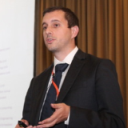Digital Solutions for Energy Management and Power Generation
A special issue of Energies (ISSN 1996-1073). This special issue belongs to the section "F: Electrical Engineering".
Deadline for manuscript submissions: closed (22 May 2019) | Viewed by 15125
Special Issue Editor
Interests: renewable energy; energy analytics; smart grids and electricity markets
Special Issues, Collections and Topics in MDPI journals
Special Issue Information
Dear Colleagues,
The digital revolution in the energy sector is producing large volumes of data with relevant impacts on the business and functional processes of system operators, energy utilities and grid users. The main challenge is to develop advanced data-driven methods, integrating domain knowledge, which extract value from data for different domains: Descriptive, predictive and prescriptive. This Special Issue aims at encouraging researchers to address the following topics of interest, but the Special Issue is not limited to only this list:
- Frequency and non-frequency system services from distributed energy resources (DER)
- Energy efficiency, smart homes and buildings
- Flexibility modelling and control of DER: standalone or combined with renewable energy sources
- Optimal combination of different energy carriers
- New business models: local energy communities, transactive energy, federated/virtual power plants, etc.
- Wholesale and retail energy markets
- Monitoring and predictive maintenance of DER
- Data privacy and economy in the energy sector
Dr. Ricardo J. Bessa
Guest Editor
Manuscript Submission Information
Manuscripts should be submitted online at www.mdpi.com by registering and logging in to this website. Once you are registered, click here to go to the submission form. Manuscripts can be submitted until the deadline. All submissions that pass pre-check are peer-reviewed. Accepted papers will be published continuously in the journal (as soon as accepted) and will be listed together on the special issue website. Research articles, review articles as well as short communications are invited. For planned papers, a title and short abstract (about 100 words) can be sent to the Editorial Office for announcement on this website.
Submitted manuscripts should not have been published previously, nor be under consideration for publication elsewhere (except conference proceedings papers). All manuscripts are thoroughly refereed through a single-blind peer-review process. A guide for authors and other relevant information for submission of manuscripts is available on the Instructions for Authors page. Energies is an international peer-reviewed open access semimonthly journal published by MDPI.
Please visit the Instructions for Authors page before submitting a manuscript. The Article Processing Charge (APC) for publication in this open access journal is 2600 CHF (Swiss Francs). Submitted papers should be well formatted and use good English. Authors may use MDPI's English editing service prior to publication or during author revisions.
Keywords
- data-driven
- artificial intelligence
- energy management
- renewable energy
- digitalization
- smart grids
- electricity market
- distributed energy resources
- energy efficiency





